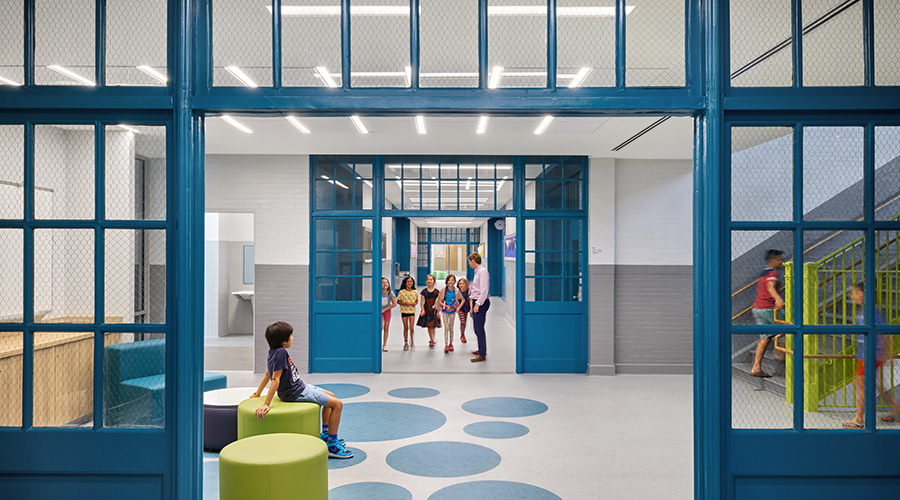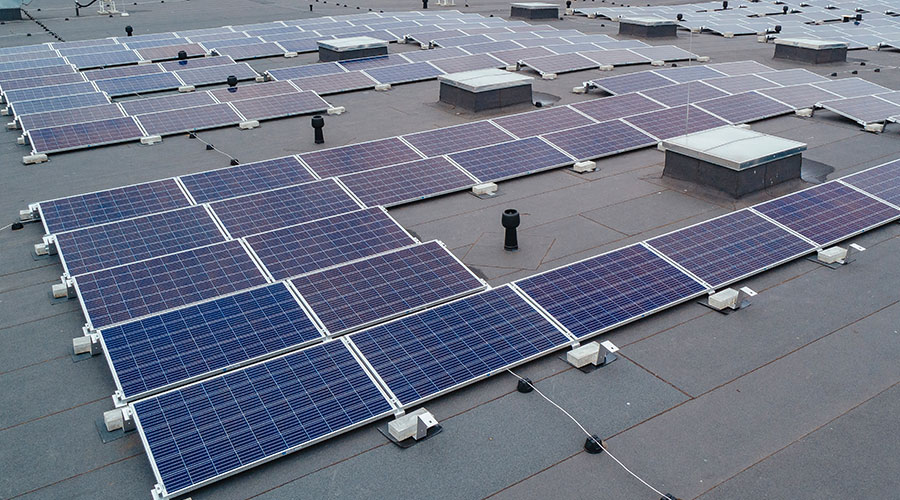Energy Focus: Strategies for Savings
Managers retrofitting commercial facilities must keep both building performance and potential energy savings in mind
The cost of energy is rising faster than inflation, but maintenance and engineering managers should view energy as a controllable cost, instead of a fixed budget expenditure.
Buildings account for about 35 percent of all energy use in the United States, including about 19 percent for commercial facilities. As renovations of existing buildings become more common, retrofitting existing commercial facilities is becoming more important.
Maintenance issues consistently were the leading complaint among commercial building tenants until the mid-1980s. Now, dissatisfaction with space temperatures has become the leading complaint. About 48 percent of energy used in a building is related to heating, ventilating, and air conditioning (HVAC).
The shortage of HVAC technicians is projected to continue for the foreseeable future, so hiring qualified technicians to run buildings will become even more challenging. This shortage is an advantage for facilities that have an automated energy-management control system. The system can assist in diagnosing problems, scheduling preventive maintenance, and making corrections and adjustments as necessary.
Opportunities Available
Supposedly, energy-saving options have been value-engineered out of many construction projects. As a result, many opportunities for good paybacks are available today in existing buildings.
New technologies, along with a dramatic improvement in equipment efficiencies, likely have made some of these options more beneficial now compared to when the building was constructed.
The American Society of Heating, Refrigerating and Air Conditioning Engineers (ASHRAE) has developed increased minimum allowable efficiencies for certain types of equipment, and many local and national building codes are adopting ASHRAE guidelines as code requirements. Many jurisdictions also have adopted the International Energy Conservation Code (IECC), which includes similar types of requirements.
For example, lighting controls, such as occupancy sensors or tandem-wired lighting circuits with bi-level switching, now must be included in all new construction or renovation projects involving lighting. Also, the maximum allowable watts per square foot have been established for various types of buildings and rooms.
The Federal Energy Policy Act of 2005 also provides incentives in the form of investment tax credits, including a 30 percent credit for fuel cell and solar technologies. Wind-power generation and the use of micro-turbines or combined heat and power — co-generation — units to generate power also are tapped for tax credits.
Allowable deductions also are available for implementing upgrades to interior lighting, HVAC, domestic hot water, and building envelopes in new or existing buildings. The amount of the deduction is the lesser of $1.80 per square foot or the cost incurred or paid for the energy-efficient property.
The energy-efficient property must meet several conditions, including certification that total annual energy or power costs are to be reduced by 50 percent or more, compared with minimum standards established by ASHRAE 90.1-2001. Partial tax deductions are available for projects that cannot meet this minimum 50 percent threshold.
Think ‘System’
Many managers have implemented energy cost-saving measures at their facilities and believe there is nothing more to do to provide a reasonable payback. But the key to a successful energy management program is to think system, rather than individual components.
The first step to energy savings is to identify no-cost opportunities that would result in an immediate payback. Examples include negotiating or switching to more favorable utility rates with the current provider or alternate providers, understanding the utility rate structure and use patterns, adjusting existing controls, and enhancing current maintenance practices and operating procedures.
The Federal Energy Management Program’s guide estimates that energy savings of 5-20 percent are attainable from operations and maintenance improvements without a significant capital investment.
Total Economic Benefit
Too often, managers evaluate energy cost-saving opportunities without considering the total net-economic benefit to the organization.
For example, accounting assumptions can have a significant impact on whether a measure would result in a favorable enough payback to be implemented.
Obviously, the goal for implementing energy cost-saving measures is to improve the organization’s bottom line by implementing projects that result in the best return on investment. Managers should evaluate all options on a standardized set of accounting assumptions to ensure an apples-to-apples comparison.
The following considerations can have an enormous impact on the overall payback of an energy cost-saving measure:
-
Include applicable sales-tax savings on energy costs, maintenance costs, etc.
-
Include the depreciation component and the impact on the resulting tax rate.
-
Reinvest the energy cost-savings, giving the project credit for investment income.
-
Consider budget energy cost-savings as an investment, instead of a fixed cost.
-
Consider the future time value of money in the life-cycle analysis.
-
Identify resources to assist in funding energy cost-saving measures, such as local utility company incentive programs, tax deductions, performance contracts, and lease-purchase agreements.
-
Consider cash flow on a monthly basis, which is consistent with utility billing cycles.
-
Act now because delaying the project until the next budget year could result in missed opportunity for savings.
Also, the Omnibus Budget Reconciliation Act of 1993 defines depreciation of HVAC equipment as 39 years. An attempt is being made to reduce this period to 15 years, which would improve the overall payback for energy cost-saving measures, including retrofits.
Jeffrey T. Hunt, P.E., C.E.M, G.B.E, CxA — jeff.hunt@feapc.com — is a senior project manager for the Dallas office of Facilities Engineering Associates, a national consulting-engineering firm headquartered in Fairfax, Va. He has more than 26 years of professional energy management experience.
LEED Update: Eye On Maintenance
For the first time in more than three years, maintenance and engineering managers working toward green certification have new guidelines to follow.
The U.S. Green Building Council (USGBC) is in the process of replacing Leadership in Energy and Environmental Design for Existing Buildings (LEED-EB) version 2.0, which was established in October 2004, with a new rating system called LEED for Existing Buildings: Operations and Maintenance (LEED-EB: O&M). Members of the USGBC have been voting to decide whether or not to institute the new system. The ballot was set to close on Nov. 26, but because less than 10 percent of USGBC members had voted on the revision, it remained open at press time.
Those who wish to pursue LEED-EB certification can do so under LEED-EB: O&M or version 2.0 until the new system is officially passed, says Taryn Holowka, USGBC’s director of communications. If and when LEED-EB: O&M does receive at least two-thirds of the vote, new projects will have to follow the revised system, not version 2.0.
Buildings being renovated according to 2.0’s guidelines will continue pursuing certification under that rating system. The projects are grandfathered through, regardless when the new system passes.
A key goal of LEED-EB: O&M, according to the USGBC web site, “is to institutionalize a process of reporting, inspection and review over the lifespan of the building.” Based on feedback from the existing building market, the LEED-EB Core Committee made multiple changes in key areas, including: sustainable sites; water efficiency; energy and atmosphere; materials and resources; and indoor environmental quality.
According to the USGBC web site, “the primary goal for revising the LEED for Existing Buildings Rating System was to reduce technical barriers to program participation, where warranted, and thereby to increase its market uptake.”
For more information, visit www.usgbc.org.
— Chris Matt, Associate Editor
|
Reducing Energy Use: Dispelling Myths
Managers encounter many misconceptions within their organizations regarding energy savings, which often result in energy waste. Below are the most common misconceptions, along with ideas to dispel them:
-
“If we reduce our energy consumption, the utility company will just raise rates.” Efficient energy use creates a win-win situation for both the consumer and the utility company. No direct correlation exists between customers energy savings and increased rates. Simply put, those who implement cost-saving measures will save money.
-
“If we reduce our energy consumption this year, our budget should be cut next year.” Ideally, any savings should be reinvested to achieve additional future savings. Managers should initiate a plan for reinvestment once the savings are realized. The budget should remain the same, and the allocated funds should be used to further efficiencies.
-
“The lower the thermostat setting, the faster the air-conditioning will cool the space.” As managers know, this system does not work like an accelerator. Efficient heating and cooling of a room depends on the relative size and efficiency of the heating, ventilation and air conditioning (HVAC) system. The system will create the same amount of warm or cool air, no matter how high or low the thermostat is set.
-
“Setting back heating and cooling equipment does not save energy, since the system has to play catch-up to reheat or recool the building the next morning.” Anytime equipment is turned off or set back, energy savings result. But HVAC technicians should be careful to control electric demand.
-
“Fluorescent lamps should not be turned off for short periods of time because the extra switching reduces lamp life, thus negating savings.” More than 90 percent of the overall cost of a lighting system is the electricity cost; so less than 10 percent includes lamp and ballast replacement. Generally, the rule of thumb is to turn it off if it’s not needed for more than two minutes.
-
“Installing extra insulation in the walls and ceiling will prevent against all energy loss.” Generally, each inch of Fiberglas insulation reduces heat flow by about 80 percent. The first inch is very productive, but the second inch only reduces 80 percent of the remaining 20 percent, or about 16 percent. So, the cost to purchase and install the extra insulation will increase expense, while the energy savings will be minimal.
— Jeffrey T. Hunt
|
Related Topics:











